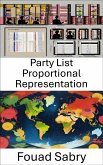Discover "Party Discipline," an insightful exploration of how cohesion within political parties shapes governance globally. This enlightening volume from the "Political Science" series highlights the importance of understanding party discipline for professionals, students, and political enthusiasts.
1: Party Discipline: Unveils mechanisms by which parties maintain unity and enforce decision-making, vital for effective governance.
2: Political Party: Explores foundational structures and roles of parties, showing how organization impacts legislative outcomes.
3: Whip (Politics): Investigates party whips' role in ensuring adherence to positions, crucial for maintaining discipline.
4: Caucus: Analyzes how party caucuses shape legislative strategies and promote cohesion among lawmakers.
5: Crossing the Floor: Examines implications of lawmakers switching parties, highlighting challenges to discipline and political stability.
6: Cabinet Collective Responsibility: Explores collective ministerial accountability, showcasing its role in enforcing unity in government.
7: Minority Leader: Discusses opposition leaders' strategic roles in upholding discipline amidst scrutiny and adversarial politics.
8: Parliamentary Group: Delves into parliamentary group functions, essential for advancing agendas and maintaining cohesion.
9: Coattail Effect: Explores how leaders' electoral successes influence down-ballot candidates, impacting discipline and strategy.
10: Party Leader: Profiles leaders' roles in enforcing discipline, shaping agendas, and navigating interparty dynamics.
11: Executive (Government): Analyzes the executive branch's enforcement of discipline through policy implementation and leadership.
12: People's Action Party: Case study on Singapore's political party, illustrating discipline strategies in a dominant-party system.
13: Primary Election: Examines primary elections' role in selecting candidates, impacting cohesion and voter engagement.
14: Presidential System: Contrasts party discipline dynamics in presidential versus parliamentary systems.
15: Backbencher: Explores backbench legislators' roles in upholding or challenging discipline within legislatures.
16: Semi-Presidential Republic: Analyzes discipline within semi-presidential systems, highlighting unique challenges.
17: List of Countries by System of Government: Provides a comparative overview of discipline across governmental structures worldwide.
18: Crossbencher: Discusses independent legislators' roles and their impact on party discipline.
19: Non-Partisan Democracy: Examines governance models with reduced party discipline and implications for democracy.
20: Indirect Election: Explores indirect election methods and their effects on party discipline in democracies.
21: Independent Politician: Profiles independents and their influence on party dynamics, reflecting on challenges to discipline.
1: Party Discipline: Unveils mechanisms by which parties maintain unity and enforce decision-making, vital for effective governance.
2: Political Party: Explores foundational structures and roles of parties, showing how organization impacts legislative outcomes.
3: Whip (Politics): Investigates party whips' role in ensuring adherence to positions, crucial for maintaining discipline.
4: Caucus: Analyzes how party caucuses shape legislative strategies and promote cohesion among lawmakers.
5: Crossing the Floor: Examines implications of lawmakers switching parties, highlighting challenges to discipline and political stability.
6: Cabinet Collective Responsibility: Explores collective ministerial accountability, showcasing its role in enforcing unity in government.
7: Minority Leader: Discusses opposition leaders' strategic roles in upholding discipline amidst scrutiny and adversarial politics.
8: Parliamentary Group: Delves into parliamentary group functions, essential for advancing agendas and maintaining cohesion.
9: Coattail Effect: Explores how leaders' electoral successes influence down-ballot candidates, impacting discipline and strategy.
10: Party Leader: Profiles leaders' roles in enforcing discipline, shaping agendas, and navigating interparty dynamics.
11: Executive (Government): Analyzes the executive branch's enforcement of discipline through policy implementation and leadership.
12: People's Action Party: Case study on Singapore's political party, illustrating discipline strategies in a dominant-party system.
13: Primary Election: Examines primary elections' role in selecting candidates, impacting cohesion and voter engagement.
14: Presidential System: Contrasts party discipline dynamics in presidential versus parliamentary systems.
15: Backbencher: Explores backbench legislators' roles in upholding or challenging discipline within legislatures.
16: Semi-Presidential Republic: Analyzes discipline within semi-presidential systems, highlighting unique challenges.
17: List of Countries by System of Government: Provides a comparative overview of discipline across governmental structures worldwide.
18: Crossbencher: Discusses independent legislators' roles and their impact on party discipline.
19: Non-Partisan Democracy: Examines governance models with reduced party discipline and implications for democracy.
20: Indirect Election: Explores indirect election methods and their effects on party discipline in democracies.
21: Independent Politician: Profiles independents and their influence on party dynamics, reflecting on challenges to discipline.
Dieser Download kann aus rechtlichen Gründen nur mit Rechnungsadresse in A, B, BG, CY, CZ, D, DK, EW, E, FIN, F, GR, H, IRL, I, LT, L, LR, M, NL, PL, P, R, S, SLO, SK ausgeliefert werden.









